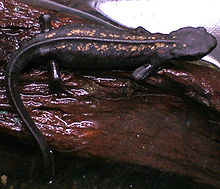- Sword-tail Newt
-
Sword-tailed Newt 
C. e. popei Conservation status Scientific classification Kingdom: Animalia Phylum: Chordata Class: Amphibia Order: Caudata Family: Salamandridae Genus: Cynops Species: C. ensicauda Binomial name Cynops ensicauda
(Hallowell, 1860)The Sword-tail newt (Cynops ensicauda) has recently been placed on Japan's Red List of Threatened Amphibians. This newt has a very small range and can only be found in some of the southernmost islands of Japan. Sometimes, Sword-tail newts are called Fire-bellied Newts, not to be confused with the common Chinese and Japanese species, because of their bright orange bellies which serve as a warning to predators that they are poisonous. They can be differentiated from these two species by their large size, broader head and (against Japanese Fire-Bellies) smoother skin. These newt ranges from brown black above, occasionally with an orange dorsal stripe. Some individuals may have light spotting or speckling on their back.
Sword-tailed newts grow from 5 - 7 inches [1] and are considered to be the largest living members of their genus. . Females and males look significantly different in appearance. Females have much longer tails that are actually longer than the rest of their bodies. Males’ tails are much shorter and sometimes display a whitish sheen during breeding season.
Habitat and distribution
The sword-tailed newt is only found on the Ryukyu Archipelago, and island chain of the southern coast of Japan, as well as on many smaller surrounding islands. This newt makes it habitat in slow, cool, stagnant bodies of water. They are commonly found in man made structures such as rice paddies, road-side ditches, and cattle waterholes. [1] There are two known subspecies of Sword-tailed newt, Cynops ensicauda ensicauda and Cynops ensicauda popei. Due to the subtropical climate of its native habitat, it is more tolerant of high temperatures than other Cynops. The Sword-tailed newt has no predators so deforestation and land development are the main reason for their endangerment.
Studies have shown that breeding places are being frequented by only a forth of the Sword Tail Newt population that was breeding fourteen years ago. This lack of breeding is another key reason for them becoming endangered. Many of their breeding places are in roadside ditches and gutters, which can lead to them being run over. Sword-tailed newts are extremely territorial, thus making moving there breeding places difficult.
References
- Kaneko & Matsui (2004). Cynops ensicauda. 2006. IUCN Red List of Threatened Species. IUCN 2006. www.iucnredlist.org. Retrieved on 11 May 2006. Database entry includes a range map and justification for why this species is labeled endangered
External links
Categories:- IUCN Red List endangered species
- Newts
- Amphibians of Japan
Wikimedia Foundation. 2010.

